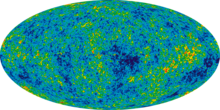
The Big Bang is a physical theory that describes how the universe expanded from an initial state of high density and temperature. The notion of an expanding universe was first scientifically originated by physicist Alexander Friedmann in 1922 with the mathematical derivation of the Friedmann equations. The earliest empirical observation of the notion of an expanding universe is known as Hubble's law, published in work by physicist Edwin Hubble in 1929, which discerned that galaxies are moving away from Earth at a rate that accelerates proportionally with distance. Independent of Friedmann's work, and independent of Hubble's observations, physicist Georges Lemaître proposed that the universe emerged from a "primeval atom" in 1931, introducing the modern notion of the Big Bang.
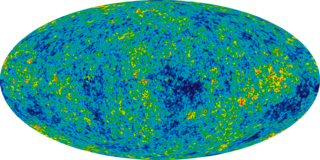
In cosmology, the study of galaxy formation and evolution is concerned with the processes that formed a heterogeneous universe from a homogeneous beginning, the formation of the first galaxies, the way galaxies change over time, and the processes that have generated the variety of structures observed in nearby galaxies. Galaxy formation is hypothesized to occur from structure formation theories, as a result of tiny quantum fluctuations in the aftermath of the Big Bang. The simplest model in general agreement with observed phenomena is the Lambda-CDM model—that is, clustering and merging allows galaxies to accumulate mass, determining both their shape and structure. Hydrodynamics simulation, which simulates both baryons and dark matter, is widely used to study galaxy formation and evolution.
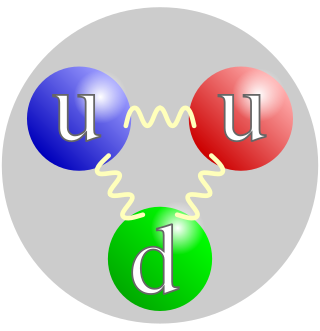
A quark is a type of elementary particle and a fundamental constituent of matter. Quarks combine to form composite particles called hadrons, the most stable of which are protons and neutrons, the components of atomic nuclei. All commonly observable matter is composed of up quarks, down quarks and electrons. Owing to a phenomenon known as color confinement, quarks are never found in isolation; they can be found only within hadrons, which include baryons and mesons, or in quark–gluon plasmas. For this reason, much of what is known about quarks has been drawn from observations of hadrons.
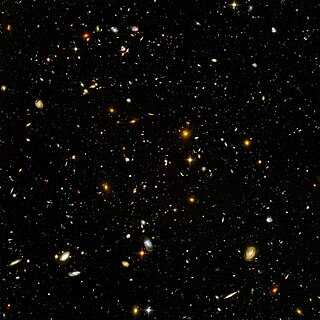
The universe is all of space and time and their contents. It comprises all of existence, any fundamental interaction, physical process and physical constant, and therefore all forms of matter and energy, and the structures they form, from sub-atomic particles to entire galactic filaments. Since the early 20th century, the field of cosmology establishes that space and time emerged together at the Big Bang 13.787±0.020 billion years ago and that the universe has been expanding since then. The portion of the universe that can be seen by humans is approximately 93 billion light-years in diameter at present, but the total size of the universe is not known.

Star formation is the process by which dense regions within molecular clouds in interstellar space—sometimes referred to as "stellar nurseries" or "star-forming regions"—collapse and form stars. As a branch of astronomy, star formation includes the study of the interstellar medium (ISM) and giant molecular clouds (GMC) as precursors to the star formation process, and the study of protostars and young stellar objects as its immediate products. It is closely related to planet formation, another branch of astronomy. Star formation theory, as well as accounting for the formation of a single star, must also account for the statistics of binary stars and the initial mass function. Most stars do not form in isolation but as part of a group of stars referred as star clusters or stellar associations.
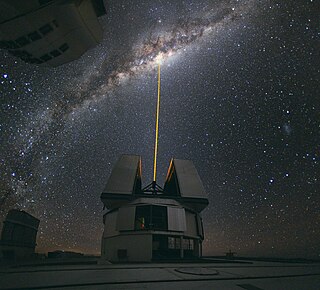
Astronomy is a natural science that studies celestial objects and the phenomena that occur in the cosmos. It uses mathematics, physics, and chemistry in order to explain their origin and their overall evolution. Objects of interest include planets, moons, stars, nebulae, galaxies, meteoroids, asteroids, and comets. Relevant phenomena include supernova explosions, gamma ray bursts, quasars, blazars, pulsars, and cosmic microwave background radiation. More generally, astronomy studies everything that originates beyond Earth's atmosphere. Cosmology is a branch of astronomy that studies the universe as a whole.

The following is a timeline of galaxies, clusters of galaxies, and large-scale structure of the universe.
In astroparticle physics, an ultra-high-energy cosmic ray (UHECR) is a cosmic ray with an energy greater than 1 EeV (1018 electronvolts, approximately 0.16 joules), far beyond both the rest mass and energies typical of other cosmic ray particles. The origin of these highest energy cosmic ray is not known.

In physical cosmology, structure formation describes the creation of galaxies, galaxy clusters, and larger structures starting from small fluctuations in mass density resulting from processes that created matter. The universe, as is now known from observations of the cosmic microwave background radiation, began in a hot, dense, nearly uniform state approximately 13.8 billion years ago. However, looking at the night sky today, structures on all scales can be seen, from stars and planets to galaxies. On even larger scales, galaxy clusters and sheet-like structures of galaxies are separated by enormous voids containing few galaxies. Structure formation models gravitational instability of small ripples in mass density to predict these shapes, confirming the consistency of the physical model.
Quark matter or QCD matter refers to any of a number of hypothetical phases of matter whose degrees of freedom include quarks and gluons, of which the prominent example is quark-gluon plasma. Several series of conferences in 2019, 2020, and 2021 were devoted to this topic.
An exotic star is a hypothetical compact star composed of exotic matter, and balanced against gravitational collapse by degeneracy pressure or other quantum properties.

In physical cosmology, the hadron epoch started 20 microseconds after the Big Bang. The temperature of the universe had fallen sufficiently to allow the quarks from the preceding quark epoch to bind together into hadrons. Initially, the temperature was high enough to allow the formation of hadron/anti-hadron pairs, which kept matter and anti-matter in thermal equilibrium. Following the annihilation of matter and antimatter, a nano-asymmetry of matter remains to the present day. Most of the hadrons and anti-hadrons were eliminated in annihilation reactions, leaving a small residue of hadrons. Upon elimination of anti-hadrons, the Universe was dominated by photons, neutrinos and electron-positron pairs. This period is referred to as the lepton epoch.

In physical cosmology, the photon epoch was the period in the evolution of the early universe in which photons dominated the energy of the universe. The photon epoch started after most leptons and anti-leptons were annihilated at the end of the lepton epoch, about 10 seconds after the Big Bang. Atomic nuclei were created in the process of nucleosynthesis, which occurred during the first few minutes of the photon epoch. For the remainder of the photon epoch, the universe contained a hot dense plasma of nuclei, electrons and photons.
This timeline lists significant discoveries in physics and the laws of nature, including experimental discoveries, theoretical proposals that were confirmed experimentally, and theories that have significantly influenced current thinking in modern physics. Such discoveries are often a multi-step, multi-person process. Multiple discovery sometimes occurs when multiple research groups discover the same phenomenon at about the same time, and scientific priority is often disputed. The listings below include some of the most significant people and ideas by date of publication or experiment.

In physical cosmology, the quark epoch was the period in the evolution of the early universe when the fundamental interactions of gravitation, electromagnetism, the strong interaction and the weak interaction had taken their present forms, but the temperature of the universe was still too high to allow quarks to bind together to form hadrons. The quark epoch began approximately 10−12 seconds after the Big Bang, when the preceding electroweak epoch ended as the electroweak interaction separated into the weak interaction and electromagnetism. During the quark epoch, the universe was filled with a dense, hot quark–gluon plasma, containing quarks, leptons and their antiparticles. Collisions between particles were too energetic to allow quarks to combine into mesons or baryons. The quark epoch ended when the universe was about 10−6 seconds old, when the average energy of particle interactions had fallen below the binding energy of hadrons. The following period, when quarks became confined within hadrons, is known as the hadron epoch.

Current observations suggest that the expansion of the universe will continue forever. The prevailing theory is that the universe will cool as it expands, eventually becoming too cold to sustain life. For this reason, this future scenario popularly called "Heat Death" is also known as the "Big Chill" or "Big Freeze". Some of the other popular theories include the Big Rip, Big Crunch, and the Big Bounce.

The chronology of the universe describes the history and future of the universe according to Big Bang cosmology.

In classical physics and general chemistry, matter is any substance that has mass and takes up space by having volume. All everyday objects that can be touched are ultimately composed of atoms, which are made up of interacting subatomic particles, and in everyday as well as scientific usage, matter generally includes atoms and anything made up of them, and any particles that act as if they have both rest mass and volume. However it does not include massless particles such as photons, or other energy phenomena or waves such as light or heat. Matter exists in various states. These include classical everyday phases such as solid, liquid, and gas – for example water exists as ice, liquid water, and gaseous steam – but other states are possible, including plasma, Bose–Einstein condensates, fermionic condensates, and quark–gluon plasma.

S5 0014+81 is a distant, compact, hyperluminous, broad-absorption-line quasar, or blazar, located near the high declination region of the constellation Cepheus, near the North Equatorial Pole.

According to the standard Big Bang theory, the early universe was sufficiently hot for all the matter in it to be fully ionised. Under these conditions, electromagnetic radiation was scattered very efficiently by matter, and this scattering kept the early universe in a state of thermal equilibrium.

